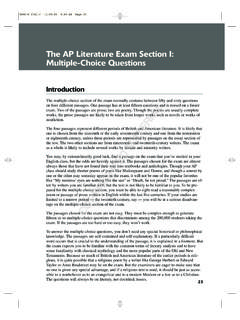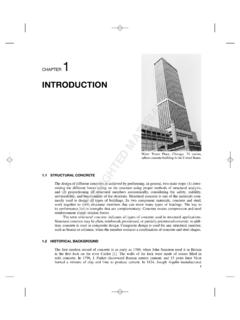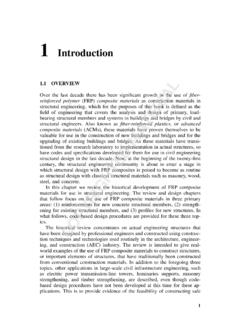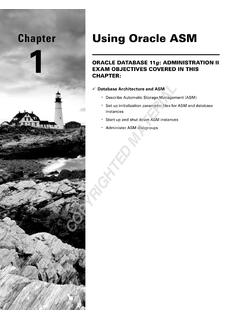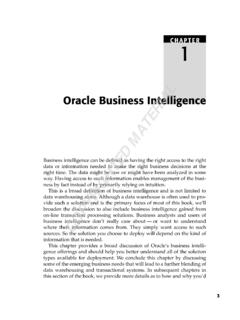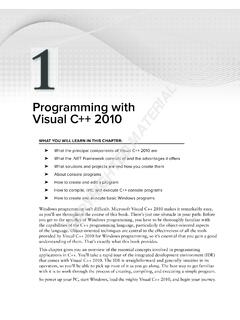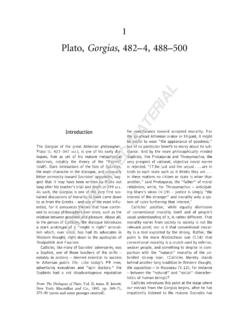Transcription of XSLT in Context - John Wiley & Sons
1 1 xslt in ContextXSLT in ContextThis chapter is designed to put xslt in s about the purpose of xslt and the task it wasdesigned to perform. It s about what kind of language it is, how it came to be that way, and how it haschanged in version ; and it s about how xslt fits in with all the other technologies that you are likelyto use in a typical Web-based application (including, of course, XPath, which forms a vital component ofXSLT). I won t be saying very much in this chapter about what an xslt stylesheet actually looks like orhow it works: that will come later, in Chapters 2 and chapter starts by describing the task that xslt is designed to perform transformation andwhythere is the need to transform XML documents. I ll then present a trivial example of a transformation inorder to explain what this means in , I discuss the relationship of xslt to other standards in the growing XML family, to put its functioninto Context and explain how it complements the other ll describe what kind of language xslt is, and delve a little into the history of how it came to be likethat.
2 If you re impatient you may want to skip the history and get on with using the language, but sooneror later you will ask why on earth did they design it like that? and at that stage I hope you will go backand read about the process by which xslt came into Is xslt ? xslt (Extensible Stylesheet Language: Transformations) is a language that, according to the very firstsentence in the specification (found ), is primarily designed for trans-forming one XML document into another. However, xslt is also capable of transforming XML to HTMLand many other text-based formats, so a more general definition might be as follows: xslt is a language for transforming the structure and content of an XML should you want to do that? In order to answer this question properly, we first need to remindourselves why XML has proved such a success and generated so much is a simple, standard way to interchange structured textual data between computer programs.
3 Partof its success comes because it is also readable and writable by humans, using nothing more complicatedXSLT in Contextthan a text editor, but this doesn t alter the fact that it is primarily intended for communication betweensoftware systems. As such, XML satisfies two compelling requirements: Separating data from presentation:the need to separate information (such as a weather forecast)from details of the way it is to be presented on a particular device. The early motivation for thisarose from the need to deliver information not only to the traditional PC-based Web browser(which itself comes in many flavors) but also to TV sets and handheld devices, not to mentionthe continuing need to produce , for many information providers an evenmore important driver is the opportunity to syndicate content to other organizations that canrepublish it with their own look-and-feel.
4 Transmitting data between applications:the need to transmit information (such as ordersand invoices) from one organization to another without investing in one-off software integrationprojects. As electronic commerce gathers pace, the amount of data exchanged between enter-prises increases daily, and this need becomes ever more course, these two ways of using XML are not mutually exclusive. An invoice can be presented onthe screen as well as being input to a financial application package, and weather forecasts can be sum-marized, indexed, and aggregated by the recipient instead of being displayed directly. Another of thekey benefits of XML is that it unifies the worlds of documents and data, providing a single way ofrepresenting structure regardless of whether the information is intended for human or machine con-sumption. The main point is that, whether the XML data is ultimately used by people or by a softwareapplication, it will very rarely be used directly in the form it arrives: it first has to be transformed intosomething order to communicate with a human reader, this something else might be a document that can bedisplayed or printed: for example, an HTML file, a PDF file, or even audible sound.
5 Converting XMLto HTML for display is probably still the most common application of xslt , and it is the one I will usein most of the examples in this book. Once you have the data in HTML format, it can be displayed onany order to transfer data between different applications, we need to be able to transform informationfrom the data model used by one application to the model used by another. To load the data into anapplication, the required format might be a comma-separated-values file, a SQL script, an HTTP message,or a sequence of calls on a particular programming interface. Alternatively, it might be another XML fileusing a different vocabulary from the original. As XML-based electronic commerce becomes widespread,the role of xslt in data conversion between applications also becomes ever more important. Just becauseeveryone is using XML does not mean the need for data conversion will will always be multiple standards in use.
6 As I write there is a fierce debate between the protagonistsof two different XML representations of office documents: the ODF specification from the Open Officecommunity, and the OOXML specification from Microsoft and its friends. However this gets resolved,the prospects of a single XML format for all word processor documents are remote, so there will alwaysbe a need to transform between multiple within the domain of a single standard, thereis a need to extract information from one kind ofdocument and insert it into another. For example, a PC manufacturer who devises a solution to a cus-tomer problem will need to extract data from the problem reports and insert it into the documents issuedto field engineers so that they can recognize and fixthe problem when other customers hit it. The fieldengineers, of course, are probably working for a different company, not for the original , linking up enterprises to do e-commerce will increasingly become a case of defining how to extractand combine data from one set of XML documents to generate another set of XML documents, and XSLTis the ideal tool for the in ContextWhat Is xslt ?
7 During the course of this chapter, we will come back to specific examples of when xslt should beused to transform XML. For now, I just wanted to establish a feel for the importance and usefulnessof transforming XML. If you are already using xslt , of course, this may be stale news. So let s take alook now at what xslt version brings to the Version came out in November 1999 and was highly successful. It was therefore almost inevitable thatwork would start on a version As we will see later,the process of creating version was far fromsmooth and took rather longer than some people hoped. However, xslt was finally published asa W3C Recommendation (that is, a final specification) in January 2007, and user reaction has been s tempting to look at version and see it as a collection of features bolted on to the language, patchesto make up for the weaknesses of version As with a new release of any other language or softwarepackage, most users will find some features here that they have been crying out for, and other additionsthat appear surplus to I think there is more to version than just a bag of goodies; there are some underlying themes thathave guided the design and the selection of features.
8 I can identify four main themes: Integration across the XML standards family:W3C working groups do not work in isolationfrom each other; they spend a lot of time trying to ensure that their efforts are coordinated. Agreat deal of what is in xslt is influenced by a wider agenda of doing what is right for thewhole raft of XML standards, not just for xslt considered in isolation. Extending the scope of applicability: xslt was pretty good at rendering XML documentsfor display as HTML on screen, and for converting them to XSL Formatting Objects for printpublishing. But there are many other transformation tasks for which it proved less with report writers (even those from the 1980s, let alone modern data visualizationtools) its data handling capabilities were very weak. The language was quite good at doingconversions of XML documents if the originalmarkup was well designed, but much weaker atrecognizing patterns in the text or markup that represent hidden structure.
9 An important aim ofXSLT was to increase the range of applications that you can tackle using xslt . More robust software engineering: xslt was always designed to be used both client-side andserver-side, but in many ways xslt optimized the language for use in the browser. However,people write large applications in xslt , containing 100K or more lines of code, and this needs amore rigorous and robust approach to things such as error handling and type checking. Tactical usability improvements:Here weareinto the realm of added goodies. The aim here isto achieve productivity benefits, making it easier to do things that are difficult or error-prone inversion These are probably the features that existing users will immediately recognize as themost beneficial, but in the long term the other themes probably have more strategic significancefor the future of the we discuss xslt in more detail and have a first look at how it works, let s study a scenario thatclearly demonstrates the variety of formats to which we can transform XML, using Scenario: Transforming MusicAs an indication of how far XML has now penetrated, Robin Cover s index of XML-based applicationstandards runs to 594 entries.
10 (The lastone is entitledMind Reading Markup Language, but as far as I can tell, all the other entries are serious.)5 xslt in ContextI ll follow just one of these 594 links,XML and Music, which takes us On this page we find a list of no less than 18 standards, proposals, or initiatives that useXML for marking up diversity is clearly unnecessary, and many of these initiatives are already dead or dying. Even thenames of the standards are chaotic: there is a Music Markup Language, a MusicML, a MusicXML, anda MusiXML, all quite unrelated. There are at least three really serious contenders: the Music EncodingInitiative (MEI), the Standard Music Description Language (SMDL), and MusicXML. The MEI derives itsinspiration from the Text Encoding Initiative, and has a particular focus on the needs of music scholars(for example, the ability to capture features found in different manuscripts of the same score), whileSMDL is related to the HyTime hypermedia standards and takes into account requirements such as theneed to synchronize music with video or with a lighting script (it has not been widely implemented,but it has its enthusiasts).
